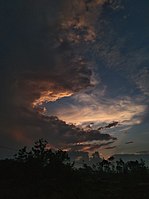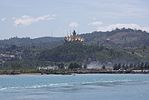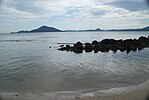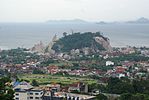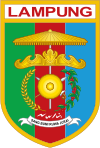Lampung Province
| Lampung | |||||||||
|---|---|---|---|---|---|---|---|---|---|
| Province | |||||||||
Clockwise, from top left : View of Lampung Bay, Pahawang Islands, Bakauheni Port and Siger Tower, Bandar Lampung, Klara Beach, Bukit Barisan Selatan National Park, Mount Anak Krakatau
|
|||||||||
|
|||||||||
| Motto(s): Sai Bumi Ruwa Jurai ("Two Peoples, One Land") | |||||||||
 Location of Lampung in Indonesia |
|||||||||
| Coordinates: 5°27′S 105°16′E / 5.450°S 105.267°ECoordinates: 5°27′S 105°16′E / 5.450°S 105.267°E | |||||||||
| Country |
|
||||||||
| Capital |
|
||||||||
| Established | 18 March 1964 | ||||||||
| Government | |||||||||
| • Body | Lampung Regional Government | ||||||||
| • Governor | Muhammad Ridho Ficardo (Democratic) | ||||||||
| • Vice Governor | Bachtiar Basri | ||||||||
| Area | |||||||||
| • Total | 35,376 km2 (13,659 sq mi) | ||||||||
| Area rank | 22nd | ||||||||
| Highest elevation | 2,262 m (7,421 ft) | ||||||||
| Population (2014) | |||||||||
| • Total | 7,972,246 | ||||||||
| • Rank | 8th | ||||||||
| • Density | 230/km2 (580/sq mi) | ||||||||
| Demonym(s) | Lampungese Warga Lampung (id) |
||||||||
| Demographics | |||||||||
| • Ethnic groups | Javanese (62%), Sundanese (9%), Lampung (25%), Malay (4%), Bantenese (3%) | ||||||||
| • Religion | Muslim (92%), Protestant (1.8%), Catholic (0.8%), Hinduism (1.7%), Buddhist (0.3%) | ||||||||
| • Languages |
Indonesian (official) Lampung (lingua franca) Lampung Nyo (dialect o) Lampung Api (dialect a) Javanese Komering Sundanese |
||||||||
| Time zone | Indonesia Western Time (UTC+7) | ||||||||
| Postcodes | 30xxx, 31xxx, 32xxx | ||||||||
| Area codes | (62)7xx | ||||||||
| ISO 3166 code | ID-LA | ||||||||
| Vehicle registration | BE | ||||||||
| HDI |
|
||||||||
| HDI rank | 24th (2014) | ||||||||
| Largest city by area | Bandar Lampung – 118.50 square kilometres (45.75 sq mi) | ||||||||
| Largest city by population | Bandar Lampung – (879,651 – 2016) | ||||||||
| Largest regency by area | Tulang Bawang Regency – 6,851.32 square kilometres (2,645.31 sq mi) | ||||||||
| Largest regency by population | Central Lampung Regency – (1,170,048 – 2016) | ||||||||
| Website | Government official site | ||||||||
Lampung is a province of Indonesia. It is located on the southern tip of the island of Sumatra and borders the provinces of Bengkulu and South Sumatra which lie to the north. Lampung is the original home of the Lampung people, who speak their own language and have their own script. Its capital is Bandar Lampung.
The province had a population of 7,596,115 at the 2010 census; the latest official estimate (as at January 2014) is 7,972,246. Three-quarters of the current population of Lampung is descended from migrants from Java, Madura, and Bali. These migrants came on their initiative, in search of more land than was available on the more densely populated islands, and as part of the national government's transmigration program, for which Lampung was one of the earliest and most significant transmigration destinations.
Lampung is commonly known for its geological instability in terms of earthquakes and volcanoes. On 10 May 2005, an earthquake measuring 6.4 on the Richter scale struck the province. The historical volcano blast of Krakatau which occurred in 1883, had disastrous consequences.
In the 7th century, word spread in China about a region located in the far south (Namphang) about a kingdom called "Tolang Pohwang". "To" meaning 'people' in Lampungese while "Lang Pohwang" the then-popular name for the region in what is now Lampung. There is strong evidence that Lampung was part of the kingdom of Srivijaya, with its regional capital in Jambi and controlling most parts of Southeast Asia including Lampung, continuing up until the 11th century. The Srivijayans came to Lampung to seek gold and amber; two things the province was known for far and wide in the past.
This fact is undergirded by unearthed evidentiary relics, with the discovery of Palas Pasemah inscriptions and the Batu Bedil inscriptions in the Tenggamus region tracing back to Srivijayan times and civilization. Other, smaller kingdoms like Tulang Bawang (name still extant as a regency in the province) and Skala Brak also existed during 7 to 8 centuries CE. The former was centered around the Tulang Bawang River, hence the name. The entry of the Banten Sultanate in Lampung at the 16th century marked the beginning of the spread of Islam in the region. Since the past, Lampung is known for pepper which at that time were much in demand. At that time the Dutch began pressing for control of the region.
...
Wikipedia



